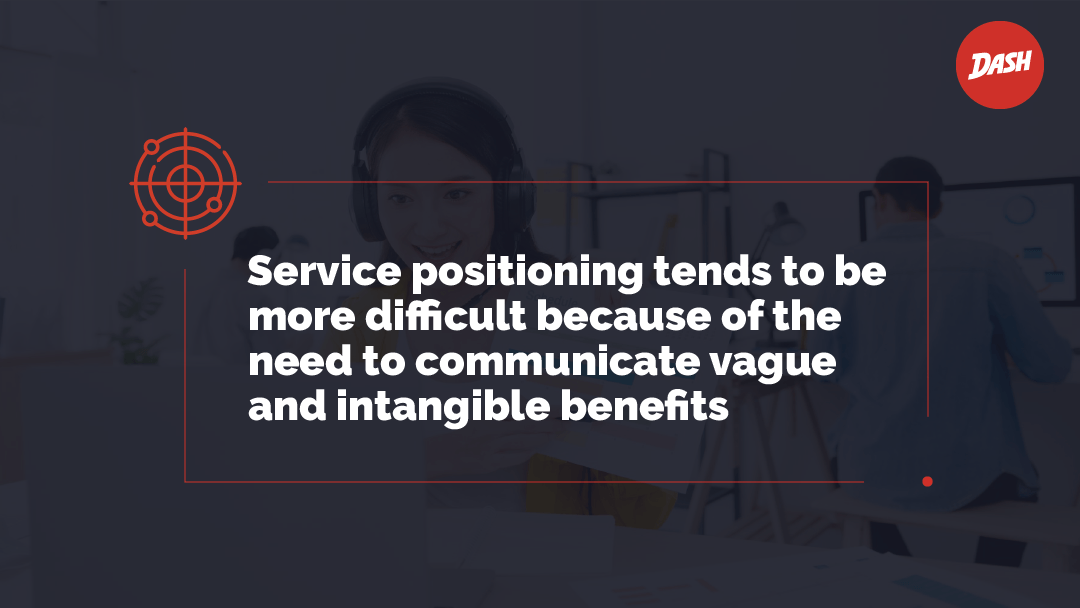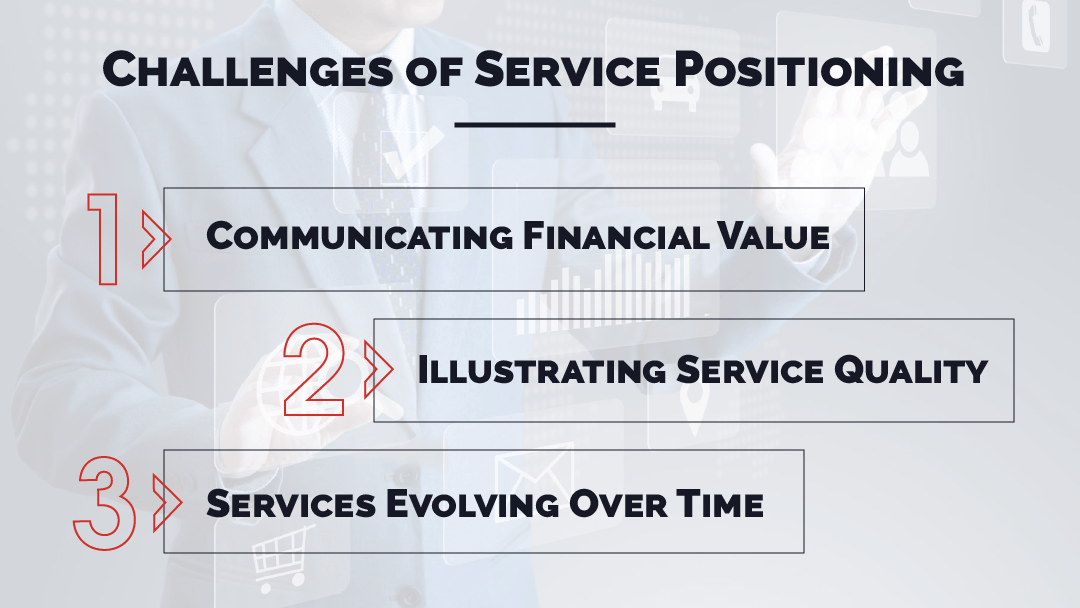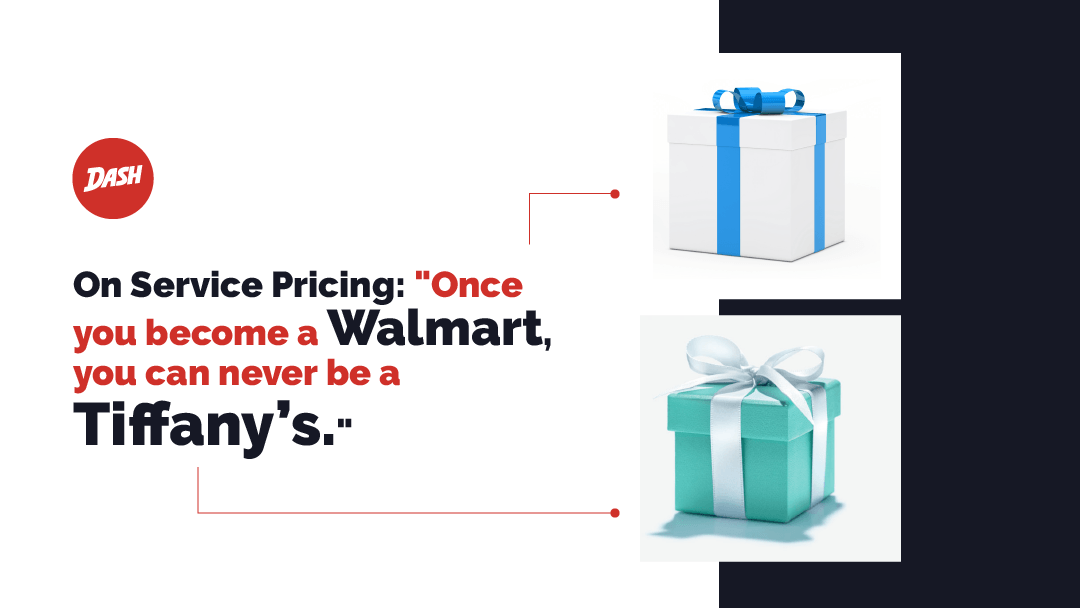Businesses that occupy a distinct place in the minds of buyers are said to be well-positioned. In previous posts, we’ve talked about how a well-positioned professional service organization has many marketing advantages over its competitors. Even under the best circumstances, though, using positioning to directly drive sales for professional services is challenging. That’s because, unlike products, services are an intangible activity that people literally have a difficult time “grasping.”

In an increasingly competitive service sector landscape, organizations that want to attract a steady stream of clients must create meaningful differentiation in their industry. Those who do stand a far better chance of carving out a distinct position in the marketplace. They also tend to grow faster and increase revenue more quickly than their non-differentiated competitors.
Some might argue there’s no significant difference between marketing products and services. Those who market professional service organizations know better than most that it can actually be quite tricky to establish service sector positioning strategies. Good planning lets you meet this challenge head-on, and the payoffs can be well worth the effort.

What is Service Positioning?
Positioning distinguishes a brand from its competitors. Successfully positioning a service requires:
- Establishing a position for your service in the minds of customers.
- Having simple, consistent messaging that’s distinct from others.
- Developing a strategy to set your service apart from your competitors.
- Avoiding trying to be all things to all people.

As part of your overall marketing strategy, positioning helps prospective clients understand what you offer and why it’s the better solution. If you fail to establish a desired position in the marketplace, you may find your professional service organization:
- Facing head-on competition from a stronger provider.
- Being forced into a position you—and no other firm—wants.
- “Blurring” its message so much know what understands how you can help them.

Positioning statements are a key feature of a brand positioning strategy for professional services. They align your marketing efforts with your brand and value proposition and ensure people understand how your service fills their specific needs.
The Difference Between Product and Service Positioning
The obvious difference between products and services is that products are tangible and services are not. Tangible products, or products you can pick up or feel, are often easier to market as customers can touch them. They’re also more easily displayed and demonstrated. People can fairly quickly determine if the product offers the value they need. The value of your services can be harder to prove. People can’t see, touch, or pick them up and examine them. Essentially, you are selling yourself. The goal of service positioning is always to develop good relationships with people and create trust in what you do.
Some service companies, of course, blur the line of products and services, especially those who market a piece of industry-specific software. While they sell or offer subscriptions of their “product,” the software, they also provide support services, upgrades, and the like.

Here are some ways marketing decisions are affected by whether what’s offered is a product or service.
- Delivery. When someone buys a product, they generally take it home with them. When they invest in a service, they typically spend time with the service provider in order to enjoy their “purchase.” It’s impossible to separate a service from its provider. For instance, if someone wants to purchase a movie from Amazon, they make a one-time purchase. If they want to enjoy the company’s streaming service, though, they need to subscribe and watch the movie from a device. Both are easy to do, but the experiences are different. When selling a service, you should aim to make the customer experience as straightforward and enjoyable as possible.
- Ownership. Products are bought, and the buyer can do with them as they please. They can dispose of them, sell them second-hand, or pass them on to someone else. Once a customer or client “consumes” a service, they cannot do any of these things with it. Many times, when people buy a product, they’re not purchasing it directly from the company that created it. A service is always connected to the person or business that creates it. That makes building a brand and positioning it crucial to success.

- Customization. Most products are designed and built to appeal to a wide range of customers. And while many can, to some degree, be personalized, services can be customized to meet a client’s exact needs. Good service positioning highlights the ways you provide custom services, not one-size-fits-all solutions.
- Returns. When a product doesn’t perform as promised out of the box, a consumer has the option of returning and physically replacing it. Once a service is consumed, it cannot be returned. This is where the goal of creating trust becomes so essential. If your firm provides subpar service, customers can’t return it, but they can demand their money back, never invest in your service again, and speak negatively about the service they received. Providing a reliable, trustworthy customer experience should be your number one priority when positioning your service.
- Time. All products have an expected lifespan, with some lasting for decades. Services are generally provided for a specific, much shorter time. People need to know that an investment they make in the short-term will benefit them well into the future.

The Challenges of Service Positioning
What makes services different from products is also what makes them challenging to position. Service positioning tends to be more difficult because of the need to communicate vague and intangible benefits.
It’s true the same basic marketing principles of place, price, and promotion apply to product and service marketing alike, but as a service provider, you must sell a potential client on the results they can expect, not the tangible object they can hold. Other factors to consider include the people and processes involved in delivering the service, as well as the physical evidence the service was delivered, such as a refund for tax services.

Along with the intangibility of services, the major challenges professional service organizations like accounting and law firms face are:
- Convincing clients their services are worth the price, particularly if the competition is offering a lower one. You need to demonstrate how the value of your service justifies the higher price.
- Illustrating their service’s quality. A service’s quality is often defined in the moment it’s being performed and can vary based on the service provider’s collective expertise and experience.
- There’s no “stocking” your services. Professional services organizations don’t have an inventory of services in a storeroom waiting to be sold. You might be able to prepare for possible surges in demand, such as at tax time, but customer faith and satisfaction rests in your ability to supply personalized services on an on-going basis.

Why is Service Positioning Important?
If you provide a general service that a lot of other companies also provide, you must find a way to stand out. In other words, if you’re perceived as just one in a long line of accountants or solicitors, you’re going to struggle to find new clients.
Sounding like all the other businesses in your field obviously doesn’t make you different. Investing in your brand and differentiating yourself from others in your sector is a crucial marketing step in getting prospective clients to understand the measurable value you offer. That’s why using tired buzzwords and phrases like “full-service” and “thinking outside the box” can make your firm seem average, not exceptional.

One way to counter this is by conveying to potential clients why you do what you do. When you can clearly convey your firm’s purpose and reason to exist, people respond by putting their trust in your abilities. Spend less time explaining how your service works and more time showing people how their lives will be better for having invested in you.

What Are Some Examples of Service Positioning Strategies?
Building a great position for your professional service organization means focusing on your calling, culture, competencies, and clients. There’s a saying in some marketing circles that once you become a Walmart, you can never be a Tiffany’s. Each brand is valuable to the people they serve, but one markets to the general public and the other markets to fewer but generally wealthier clients who want specialized services and unique products.
Providing a service is all about the people you’re providing it to. It’s a relationship that, like all others, must be clearly defined if the best possible results are to be achieved. General service descriptions include things like:
- What the service is.
- Why the service is essential.
- What the service’s benefits are.
- What results prove the service has been successfully delivered.

Developing a transparent service description ensures your clients understand what to expect during the process. By establishing a framework for the relationship, you minimize misunderstandings and set up a scenario where everyone is happy with the outcome.
How does this process work in the real world? Say you’re an accounting firm that wants to create a truly unique position in the market. We’ve talked before about how your unique value proposition can set you apart from every other provider who offers your same core services. Here are a few approaches a CPA or accounting firm might use.

- Focusing on a specific target client such as sophisticated investors, high-net-worth individuals, or real estate investors. Or you might focus on a specific industry like manufacturing, eCommerce, or entertainment.
- Focusing on a specific service like business valuation, SMSF audits, or insolvency.
- Focusing on a unique process, like preparing a company for exit, managing growth in SMBs, or maximizing cashflow for family businesses.
Creating a unique position in your industry is a proven strategy for attracting more clients who want and are willing to pay for your services. It can be likened to building a moat around your professional service organization to protect it from the marauding competition.

Successfully positioning your service organization requires an in-depth understanding of how to design, package, and market intangible benefits to improve its performance. A well-developed brand positioning strategy attracts people to your firm and keeps them there as loyal customers. And once you establish a position people put their faith in, you create the ability to remain highly competitive, no matter how fierce the contest.



